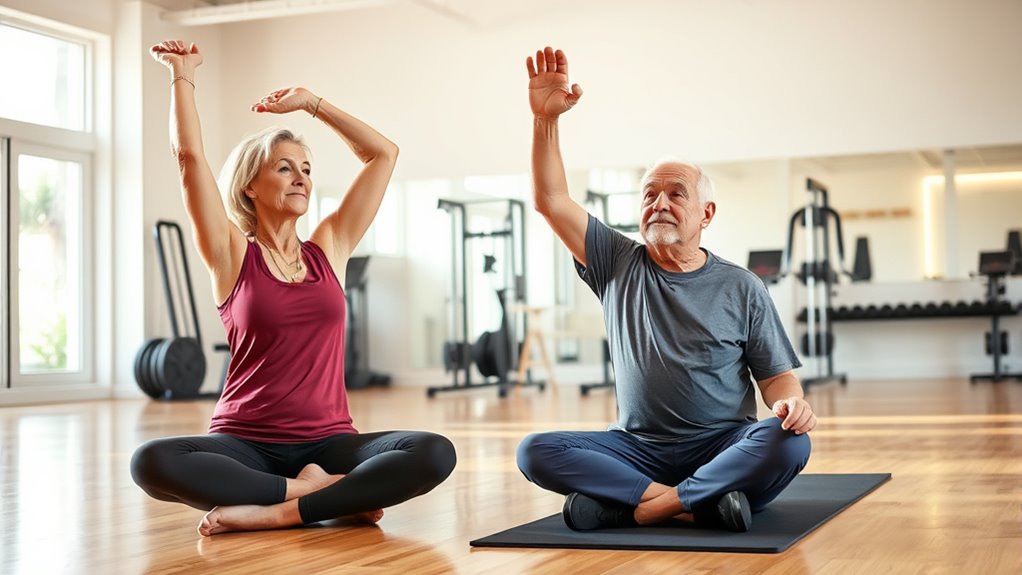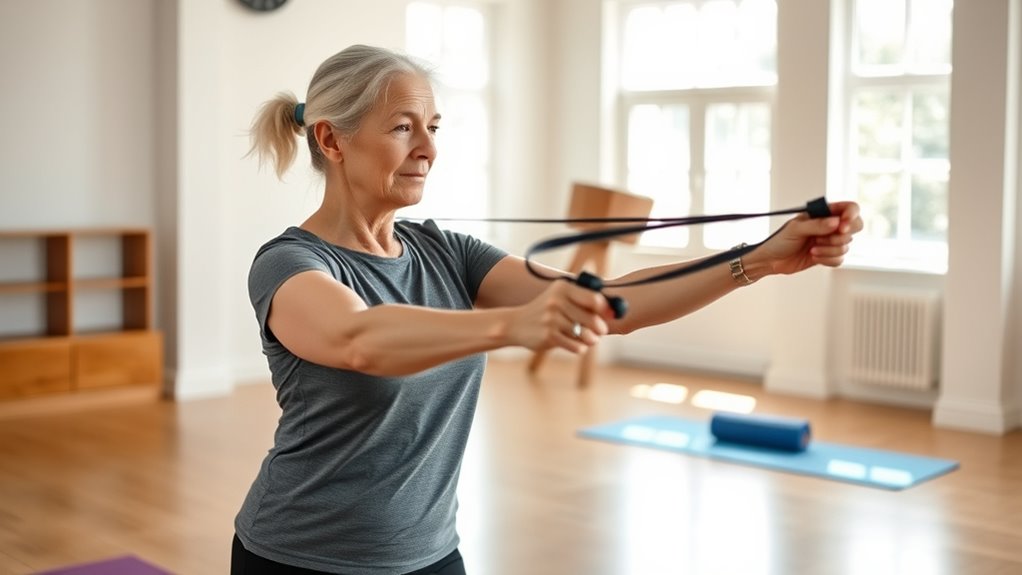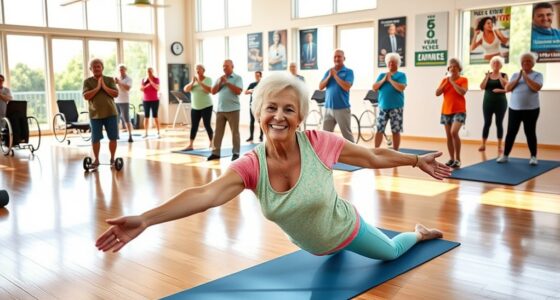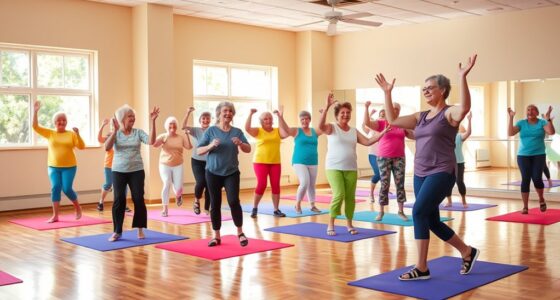Getting started with strength training as a senior involves focusing on safe, low-impact exercises that boost muscle mass and balance. Use light weights or resistance bands and concentrate on controlled, proper movements. Incorporate warm-up and cool-down routines, and listen to your body to prevent injury. Vary your workouts to stay motivated and adapt exercises to your fitness level. Keep moving forward, and you’ll discover practical tips to build strength and confidence along the way.
Key Takeaways
- Consult healthcare professionals before starting any new strength training routine.
- Begin with low-impact exercises using light weights or resistance bands.
- Focus on proper form, controlled movements, and gradual progression to ensure safety.
- Incorporate warm-up, stretching, and cool-down routines to prevent injury and improve mobility.
- Establish a consistent schedule, vary exercises, and listen to your body for sustained progress.
Why Strength Training Matters for Seniors

Strength training matters for seniors because it helps preserve muscle mass that naturally declines with age. As you age, losing muscle can make daily activities more difficult and increase fall risk. Regular strength training keeps your muscles strong, supporting your mobility and independence. It also improves bone density, lowering the chances of osteoporosis and fractures. Building strength through resistance exercises enhances your balance and coordination, reducing the risk of falls. Additionally, strength training can ease symptoms of chronic conditions like arthritis, diabetes, and heart disease. Engaging in age-appropriate resistance workouts promotes better posture and helps reduce back and joint pain. Incorporating lightweight equipment such as resistance bands or small weights can make your workouts more effective and accessible. Being aware of regional resources and guidance can help you find suitable classes or trainers tailored for seniors to ensure safe and effective exercise routines. Understanding muscle preservation techniques can further optimize your strength training efforts.
Designing a Safe and Effective Workout Routine

Creating a safe and effective workout routine for seniors involves selecting low-impact, osteoporosis-friendly exercises that avoid bending or twisting the spine. To guarantee safety and effectiveness, make sure your routine includes: 1. Focused lower body exercises, like gentle squats, to strengthen the front of your thigh and reduce knee pain. 2. Balanced upper body movements, such as light resistance exercises, for improved mobility. 3. Combining exercises to promote overall strength while minimizing joint stress. 4. Using light weights (3-5 lbs) and slow, controlled movements to maximize muscle engagement and prevent injury. Incorporating appropriate screening methods can help tailor your exercise plan to your individual health needs. Additionally, selecting diverse exercise equipment or planters designed for low-impact workouts can enhance safety and motivation during training. Engaging in evidence-based exercise routines can further improve your overall safety and effectiveness. Regularly consulting with healthcare professionals and staying informed about osteoporosis-friendly exercises ensures your workout remains safe and beneficial. Incorporating proper warm-up and cool-down techniques can also help prevent injuries and improve flexibility during your routine.
Warm-Up and Cool-Down: Preparing Your Body

Starting your workout with gentle movements like arm circles and step touches helps get your muscles ready and reduces injury risk. Incorporating stretching techniques guarantees your joints stay flexible and prepared for activity. Using protective styling benefits during warm-up and cool-down can help prevent unnecessary strain on your hair and scalp. After exercising, cool-down routines relax your muscles and improve mobility, preventing stiffness. Regularly engaging in proper warm-up and cool-down practices also supports overall indoor air quality, which is essential for maintaining health during your fitness routine. Additionally, mindful movement during warm-up and cool-down can enhance your overall space and organization, making your exercise area safer and more efficient. Understanding the importance of city dynamics can help you set up a more effective and enjoyable workout environment at home or in your community space. Incorporating glycolic acid benefits into your skincare routine can also help maintain healthy skin, especially if you are exposed to outdoor elements during your activities.
Gentle Movement Routines
Before diving into more intense exercises, it’s important to begin with gentle movement routines that prepare your body. These routines, like arm circles, step touches, and torso twists, help gradually elevate your heart rate and improve mobility. Incorporating light stretches during warm-up, such as shoulder and hip openers, enhances flexibility and lubricates joints. To optimize your routine, consider these steps:
- Start with slow, controlled arm circles to loosen shoulder joints.
- Perform step touches to gently engage leg muscles and boost circulation.
- Do torso twists to improve spinal mobility and warm up your core.
- Finish with light stretches like shoulder and hip openers to increase flexibility.
Proper warm-up techniques can further enhance your workout safety and effectiveness. Additionally, understanding market trends can help you make informed decisions about your fitness journey. For example, exploring different virtual workout options can make your warm-up routine more engaging and accessible. Incorporating professional guidance can also ensure exercises are performed safely and effectively. Staying aware of emerging health technologies can further support your fitness goals by providing innovative tools and resources.
Muscle Preparation Techniques
A proper warm-up is essential to prepare your muscles and joints for strength training. It increases blood flow, which helps reduce injury risk and makes your muscles more flexible. Gentle movements like arm circles, step touches, and torso twists loosen muscles and improve mobility. These light exercises activate your body without overexerting you. Incorporating muscle preparation techniques such as warm-up and cool-down routines can further optimize your training. During warm-up, focus on deep breathing to promote relaxation and better oxygen flow. After your workout, a cool-down routine is just as important. Stretch key muscle groups such as your hamstrings, shoulders, and hips to boost flexibility and support recovery. Incorporating deep breaths during cool-down helps manage fatigue and calms your nervous system. Regularly doing these preparation and recovery techniques can enhance your overall mobility and make your strength training safer and more effective. Additionally, understanding exercise safety measures can help prevent injuries and ensure a successful workout routine. Recognizing how proper energy distribution enhances workout efficiency can also contribute to better performance. Incorporating proper hydration before and after exercise supports muscle function and recovery.
Effective Stretching Strategies
Effective stretching strategies are essential for preparing your body before strength training and supporting recovery afterward. Proper warm-up routines boost blood flow, loosen muscles, and prepare your joints, reducing injury risk. Incorporate gentle stretches like arm circles and torso twists to enhance flexibility and ready your muscles. Using dynamic stretches can further improve your mobility and prepare your body for activity. Engaging in dynamic movements during warm-up can activate multiple muscle groups simultaneously, enhancing overall readiness. Additionally, studies show that pre-exercise stretching can help prevent injuries and improve performance. Incorporating proper hydration is also important for maintaining muscle function and recovery. After exercising, cool-down stretches such as hamstring and hip flexor stretches promote muscle relaxation and help maintain flexibility. Dynamic movements and light stretches at the start and end of your workout are especially beneficial for seniors, improving mobility and preventing stiffness. To maximize benefits, consider these steps: 1. Warm-up with gentle, dynamic stretches 2. Focus on movements that mimic your workout 3. Cool down with targeted stretches 4. Hold each stretch gently without bouncing
Key Exercises to Build Strength and Flexibility

To build strength and improve flexibility, you should focus on gentle resistance exercises like front raises and squats.
Incorporating mobility stretches for your hips and hamstrings helps protect your joints and enhances movement.
Using proper form and controlled motions guarantees you get the most benefit while reducing injury risk.
Gentle Resistance Moves
Gentle resistance moves are a safe and effective way for seniors to build strength and enhance flexibility. Using light weights or resistance bands, you can perform controlled, slow movements that maximize muscle engagement while reducing injury risk.
Key exercises include:
- Front raises to strengthen shoulders
- Overhead presses for upper body stability
- Bicep curls to maintain arm strength
- Seated rows to support back muscles
Focusing on proper form and breathing helps prevent strain and ensures effective activation of muscles.
Incorporating these resistance exercises into your routine can boost bone density, stabilize joints, and improve overall mobility. When done regularly, these moves support independence and help reduce fall risk, making resistance training a crucial part of your health journey.
Flexibility and Mobility Exercises
Are you looking to improve your flexibility and mobility? Incorporating simple stretches like toe touches and lunges can boost your hamstring and hip flexor flexibility, lowering injury risk.
Shoulder and neck mobility exercises, such as arm crosses and circles, help you maintain a full range of motion needed for daily tasks.
Stretching your quadriceps and hips with ankle grabs or figure-four positions enhances stability and lower body flexibility.
Glute and hip-opening stretches, like crossing legs and hinging hips back, relieve tightness and promote movement.
Combining gentle deep breathing with these stretches relaxes muscles, increases flexibility, and supports recovery.
Regular practice makes daily activities easier and helps prevent injuries, keeping you active and strong.
Tips for Staying Motivated and Consistent

Staying motivated and consistent with strength training becomes easier when you set small, achievable goals that give you a sense of progress. Celebrating these milestones keeps you focused and energized.
To further boost motivation:
- Vary your exercises regularly to prevent boredom and stay engaged.
- Track your progress by noting increased weights or repetitions, providing tangible proof of your improvements.
- Find a workout buddy or join a group class for social support, accountability, and encouragement.
- Establish a consistent schedule, like exercising at the same time each day, to develop a routine and make training a habit.
Implementing these strategies helps you stay committed, making your strength training more enjoyable and sustainable over the long term.
Adapting Exercises to Your Fitness Level

To guarantee your strength training remains safe and effective, it’s important to adapt exercises to match your current fitness level. Start with lighter weights or resistance bands, gradually increasing intensity as you build strength.
If an exercise feels too challenging, reduce the range of motion or repetitions to prevent injury and avoid overexertion. Focus on maintaining proper form and controlled movements to maximize safety and results, no matter where you’re starting from.
If an exercise is too difficult, modify it to stay safe and maintain proper form.
If standing exercises become difficult, try seated or supported options to stay active comfortably. Always listen to your body—if you feel fatigue or discomfort, slow down or adjust the exercise’s pace, intensity, or duration.
Adapting your workouts ensures you stay safe, motivated, and progress steadily.
Frequently Asked Questions
How Many Times a Week Should Seniors Do Strength Training?
You should aim for strength training about two times a week. This frequency helps you build muscle, improve bone density, and boost your overall function without overstraining your body.
Make sure to give your muscles at least 48 hours to recover between sessions. Starting with twice a week is a safe, effective way to gradually increase your strength and maintain your health as you age.
What Is the 3-3-3 Rule Gym?
You might wonder if a quick workout can be effective, and the 3-3-3 Rule Gym proves it. It’s a simple, structured approach that guides you through three minutes of warm-up, three sets of strength exercises, and three minutes of cool-down.
This routine promotes consistency, safety, and gradual progress, making it perfect for beginners and seniors. It’s a manageable way to build strength without overexertion.
How to Start Strength Training at 70?
To start strength training at 70, begin with light weights or resistance bands to keep safe.
Focus on standing, osteoporosis-friendly exercises like squats and arm lifts, doing 1-2 sets of 8-12 reps.
Always warm up and cool down to prevent stiffness and improve mobility.
Before starting, check with your healthcare provider, especially if you have health concerns, to make certain your routine is safe and effective.
What Is the 6 12 25 Rule?
You probably think there’s a magic number for strength training, right? Well, the 6-12-25 rule is it. It means doing 6 to 12 reps per set, each lasting about 25 seconds, with 12-second rests in between.
This simple guideline helps you build muscle effectively without overdoing it, making your workouts safer and more efficient.
Stick to it, and you’ll see steady strength gains with less risk of overexertion.
Conclusion
Starting strength training now is like planting seeds for a healthier future. With dedication and the right guidance, you’ll watch your confidence grow and your body flourish. Remember, every small step counts on this journey—think of it as building a sturdy foundation for a vibrant, independent life. Embrace the process, stay consistent, and soon you’ll find that strength isn’t just physical; it’s a powerful act of self-love that keeps you thriving.









